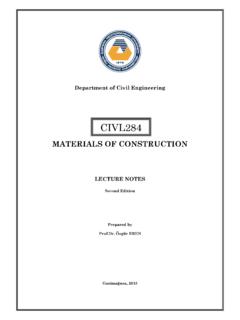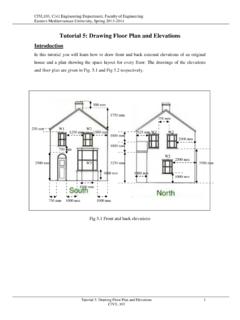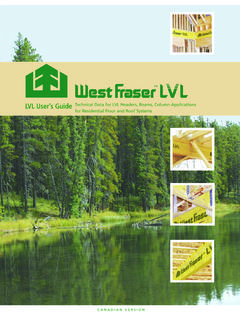Transcription of FORMWORK - EMU
1 FORMWORK . INTRODUCTION. FORMWORK is a mould or open box, like container into which fresh concrete is poured and compacted. When the concrete is set, the FORMWORK is removed and a solid mass is produced in the shape of the inner face of the FORMWORK . The top of the FORMWORK is normally left open. Falsework is the necessary support system that holds the FORMWORK in the correct position. FORMWORK FOR CONCRETE. STRUCTURES SHOULD BE. 1. Strong enough to resist the pressure or the weight of the fresh concrete plus any constructional live loads.
2 2. Rigid enough to retain the shape without undue deformation. 3. Economical in terms of the total cost of the forms and the concrete surface finishing when required. 4. Sufficiently watertight to avoid leakage at the joints. FORMWORK ECONOMY. In order to reduce the cost of FORMWORK for concrete structures the following are to be considered: 1. Design the FORMWORK to provide adequate but not excessive strength and rigidity. 2. Fabricate the forms into modular sizes to provide more reuses without refabricating when practical.
3 3. Prepare working drawings prior to fabricating the forms. 4. Prefabricate form sections on the ground rather than on scaffolding. FORMWORK ECONOMY (continued). 5. Use the most economical FORMWORK material considering the initial cost and reuses. 6. Use no more nails than are needed to join the forms together safely. 7. Remove the FORMWORK as soon as it is permissible. 8. Clean and oil forms by using releasing agent after each use. 9. When it is permissible install construction joins to reduce the total quantity of form material required and permit the carpenters to work more continuously.
4 FORMWORK MATERIALS. FORMWORK materials can be classified as: 1. Timber 2. Metals 3. Plastics Timber FORMWORK a. Lumber: Lumber is commonly available material and has excellent strength, weight and cost factor. Lumber is classified as: Boards: 1 to inches thick, 2 or more inches width Dimensions: 2 to 4 inch thick, any width. Timbers: 5 or more inches thickness, 5 or more inches width b. Plywood The use of plywood in concrete forming for form facing has improved the quality of finished concrete. The relatively large sheets of plywood have reduced the cost of building and at the same time have provided smooth surfaces that reduces cost of finishing of concrete surfaces.
5 PIywood is a manufactured wood product consisting a number of veneer sheets, or plies Type of plywood can be grouped as exterior and interior. For FORMWORK the exterior plywood is used. Adhesive used to bond the piles in manufacturing of exterior plywood is watertight and gives maximum number of reuses. Metal FORMWORK 2. Metals The initial cost of metal FORMWORK is more than timber FORMWORK but the umber of reuses of metal FORMWORK is higher than that of timber. in long run metal FORMWORK can be economical.
6 N heavy construction works metal formvvork may require a lifting mechanism to handle the formvvork panels or props. Steel sheet formvvork has the problem of rusting also. To avoid rusting, in every use the surfaces should be oiled with an appropriate releasing agent. in metal formvvork usage, the metal sheets are prepared as panels of standard sizes. This brings the difficulties of erecting irregular dimensions of formvvork. Steel or aluminum or magnesium is the most widely used metals. Plastic FORMWORK 3.
7 Plastics They have impervious surfaces that usually create a smooth f nish to the concrete. Plastic FORMWORK could be reinforced or un- reinforced. Plastic is reinforced by glass fibers. Reinforced plastics are specially produced for a specific formvvork type. Un-reinforced plastics are produced in sheet form with smooth or textured surfaces. Plastic FORMWORK is lighter but less durable than metal formvvork. FORMWORK TYPES (BY SHAPE). Considering shapes, for mvork types can be classified as: Column FORMWORK Beam FORMWORK Slab F6rmwork Wall FORMWORK Column FORMWORK Column FORMWORK Column FORMWORK is made usually with either timber or metal panels.
8 The principle is to create an enclosed box with frames at the exact size of the column and fix it tightly on the kicker left from base or at the last stage of column concreting. The box is held in position by steel column clamps or bolted yokes and supported by timber studs or props Beam FORMWORK Beam FORMWORK Beam FORMWORK consists of open through section and because it is not closed at the top requires more supporting framework to restrain the sides. The supports need to be maintained to the soffit and also provide lateral support to the sides.
9 In timber this is done by the use of a headtree across the top of a vertical member. Metal panels are used with corner pieces, but timber headtrees are needed for vertical support. Slab Floor FORMWORK Slab FORMWORK Floors require a large area of FORMWORK to be provided usually fron beam to beam. Timber floor FORMWORK consists of timber boards or plyvvoo sheets supported on a fra nework and resting on a series of timber joists. Again timber and metal props can be used for vertical supports. Metal panels can be used and bolted or clipped togetherand held in place by a system of metal beams or a tabular scaffold system.
10 Adjustable props need for levelling purposes Wall FORMWORK Wall FORMWORK Wall FORMWORK is a simpler than for other concrete units as the actual forces against it are less, most of the load being carried vertically downwards. The panels at both sides are held in position by ties. Ties are also used as spacer, arranging wall thickness. WaII support systems are usually sloping props at satisfactory intervals. FORMWORK STRIKING TIMES. The time to be allowed before FORMWORK can be removed naturally depends on many factors, such as: type of concrete mix used (type of cement).






